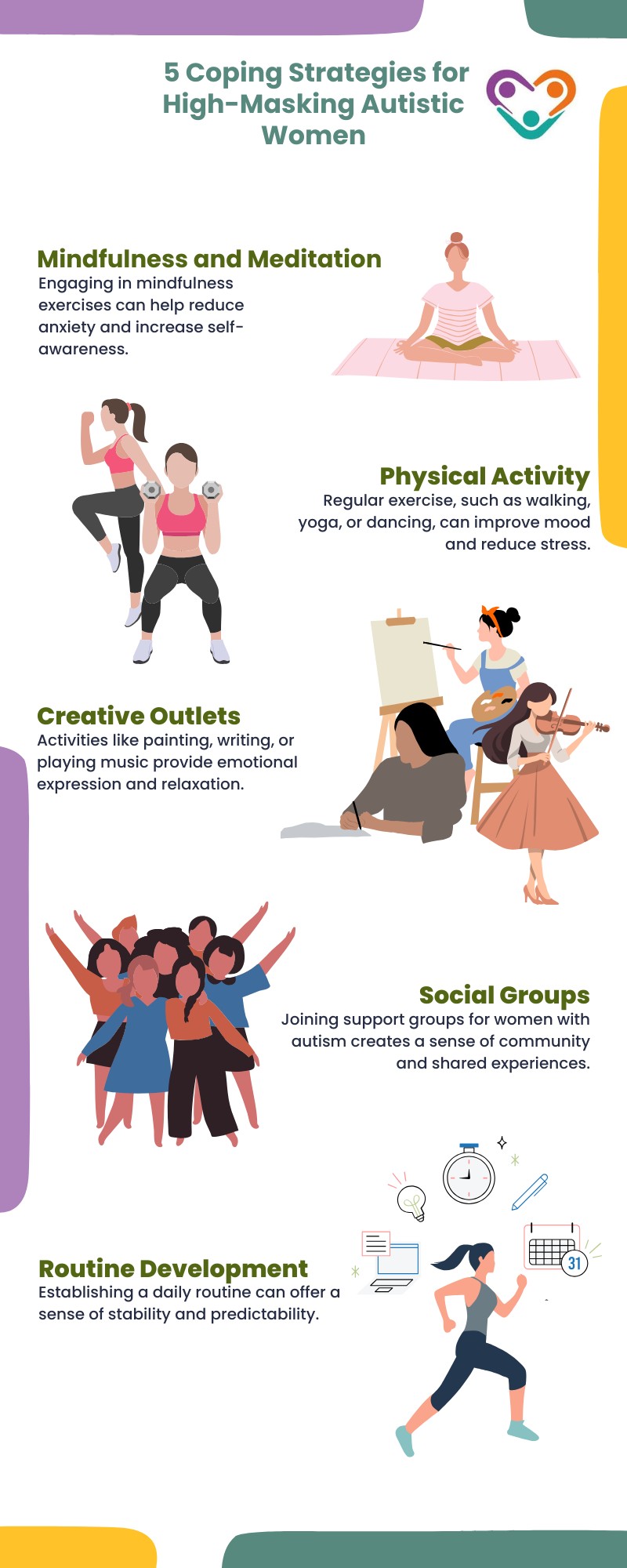Masking in autism refers to the conscious or unconscious effort made by individuals, particularly women, to hide or suppress their autistic traits in social situations. This behavior often involves mimicking neurotypical peers and adopting socially acceptable behaviors to fit in.
Masking can include various actions, such as imitating facial expressions, controlling movements, and rehearsing conversations.
The concept of masking is essential for understanding the experiences of individuals with autism, especially women, who may feel pressure to conform to societal norms.
How Does Masking Present in Women with Autism?
High masking in women with autism can manifest in several ways, reflecting the unique challenges they face in social situations. Women may engage in a range of behaviors to mask their true feelings and traits.
Here are some common presentations of masking in women with autism.
- Mimicking Social Interactions: Imitating speech patterns, gestures, and body language of peers.
- Controlled Emotions: Suppressing natural emotional responses to appear more socially acceptable.
- Scripted Conversations: Preparing specific topics or questions to discuss in social situations.
- Avoiding Autistic Traits: Making a conscious effort not to display behaviors such as stimming or atypical interests.
- Adapting Interests: Showing interest in topics that are more socially typical, even if they are not genuine.
These behaviors allow women to navigate social environments by attempting to blend in with their peers. However, engaging in high masking can be exhausting and may lead to increased stress, anxiety, and a disconnection from one’s authentic self.
Understanding these aspects of masking is critical for parents, caregivers, and individuals with autism to foster acceptance and support in social contexts.
Challenges of High Masking
High masking in women with autism can present unique challenges that affect social interactions and emotional well-being. Understanding these difficulties is crucial for parents and caregivers, as well as for individuals experiencing masking themselves.
Women who engage in high masking may face significant social challenges. They often work hard to fit in, which can lead to exhaustion and feelings of isolation.
The pressure to conform to societal expectations can hinder authentic connections with others.
Also, the emotional toll of high masking is profound. Maintaining a facade can create internal conflict and mental fatigue, impacting self-esteem and emotional regulation.
Recognizing these challenges is vital for providing support and understanding for those navigating life with high masking in autism. Strategies must be developed to address social and emotional difficulties, fostering a sense of acceptance and well-being.
Impact on the Daily Lives of Autistic Women
High masking in women with autism can have significant consequences on various aspects of daily life. This includes relationships, social interactions, and mental health, all of which can be profoundly influenced by the pressure to conform to social norms.
Women with high masking may find themselves struggling to form authentic relationships. The effort to conceal their true selves can lead to feelings of detachment and isolation.
Here are some common challenges they may face:
- Difficulty in forming deep connections
- Strain due to misunderstandings and a lack of communication
- Fear of vulnerability and rejection
These challenges can prevent meaningful connections and hinder their ability to navigate social settings comfortably.
Also, the mental health of women who engage in high masking can be severely impacted. Constantly suppressing one’s true identity can lead to various psychological issues. These may include anxiety, depression, and burnout.
The emotional toll of high masking often leads to a decline in overall well-being. Recognizing these effects is crucial for parents, caregivers, and individuals themselves to foster a supportive environment that prioritizes authenticity and mental health.

How to Recognize High Masking in Autistic Women
Identifying high masking in women with autism can be complex, yet it is crucial for understanding their experiences and supporting their needs.
High masking is often characterized by various behaviors and traits that may obscure the underlying autism traits. Women may adopt certain tendencies to fit in socially or to avoid discomfort.
Here are some common signs:
- Imitating gestures, expressions, or language of peers
- Maintaining minimal eye contact to navigate social situations
- Excessively adhering to social norms and expectations
- Struggling to convey true feelings or emotions
- Being sensitive to sensory input but masking reactions
- Feeling drained after social interactions despite appearing engaged
Diagnosis and Assessment
Diagnosing high masking in women with autism involves a comprehensive evaluation process. This often includes interviews, behavior assessments, and questionnaires aimed at gathering information from multiple sources.
Healthcare professionals may conduct interviews with the individual and their caregivers to identify patterns of behavior and social interactions. Professionals may also observe social interactions in various environments to assess masking behaviors and overall functioning.
The diagnosis may involve collaboration between psychologists, psychiatrists, and other specialists to ensure a holistic understanding of the individual’s experiences. It is essential to consider the cultural and social context while recognizing high masking, as behaviors may vary widely across different environments.
By understanding the signs and processes involved in diagnosing high masking, parents and caregivers can better support women with autism and advocate for their needs. For a deeper look at communication challenges that often go unnoticed, explore our article, Understanding Selective Mutism in ASD.
5 Coping Strategies for High-Masking Autistic Women
Practicing self-care and seeking support is vital for individuals experiencing high masking in women with autism. It allows for better management of stress and emotional well-being.
Here are some strategies that can help:

Creating a network of understanding friends or family members who can listen and provide emotional support is equally important. Connecting with others who are familiar with the challenges of high masking can foster greater understanding and companionship.
For many, professional assistance is necessary to navigate the complexities of high masking. Therapy and counseling can provide valuable tools and coping mechanisms. The following types of professional help may be beneficial:
- Psychologists
- Occupational therapists
- Support groups
- Counseling services
Engaging with a qualified professional ensures that individual needs are met effectively. Together with proper support and self-care techniques, women with autism can work towards better overall well-being while managing the challenges associated with high masking.
Conclusion
Masking in autism, especially among women, is a complex and often exhausting effort to hide autistic traits to fit into social norms. While it can help navigate social situations, high masking often comes at a cost, affecting mental health, relationships, and overall well-being.
Recognizing the signs of masking and understanding its impact allows for better support and acceptance. At Golden Care Therapy, we offer high-quality, individualized ABA therapy that goes beyond surface behaviors to truly understand and support each child.
Our autism services in New Jersey, Indiana, New York, Georgia, and Florida are rooted in compassion, experience, and a deep commitment to helping children thrive in their everyday environments. If you’re looking for meaningful, consistent progress and a team that genuinely cares, contact us today so we can walk this journey with you.
Sources:



